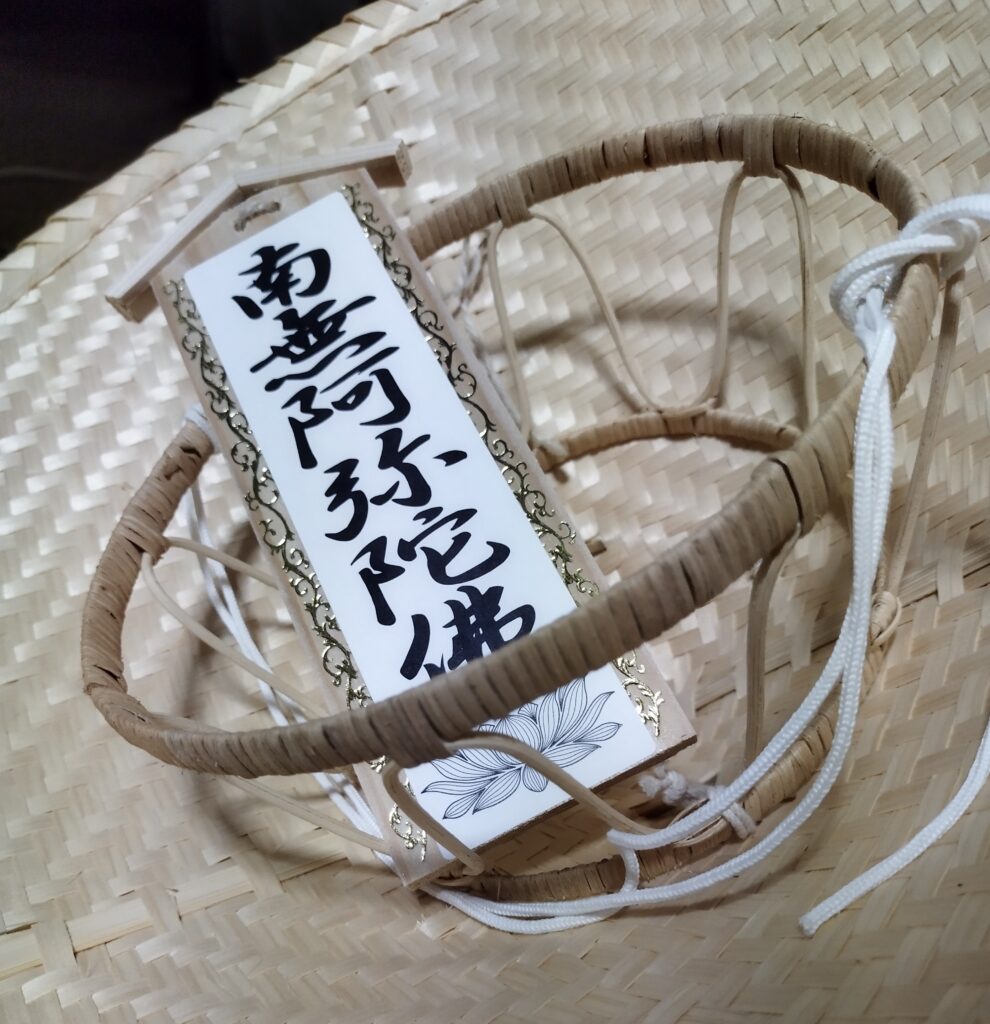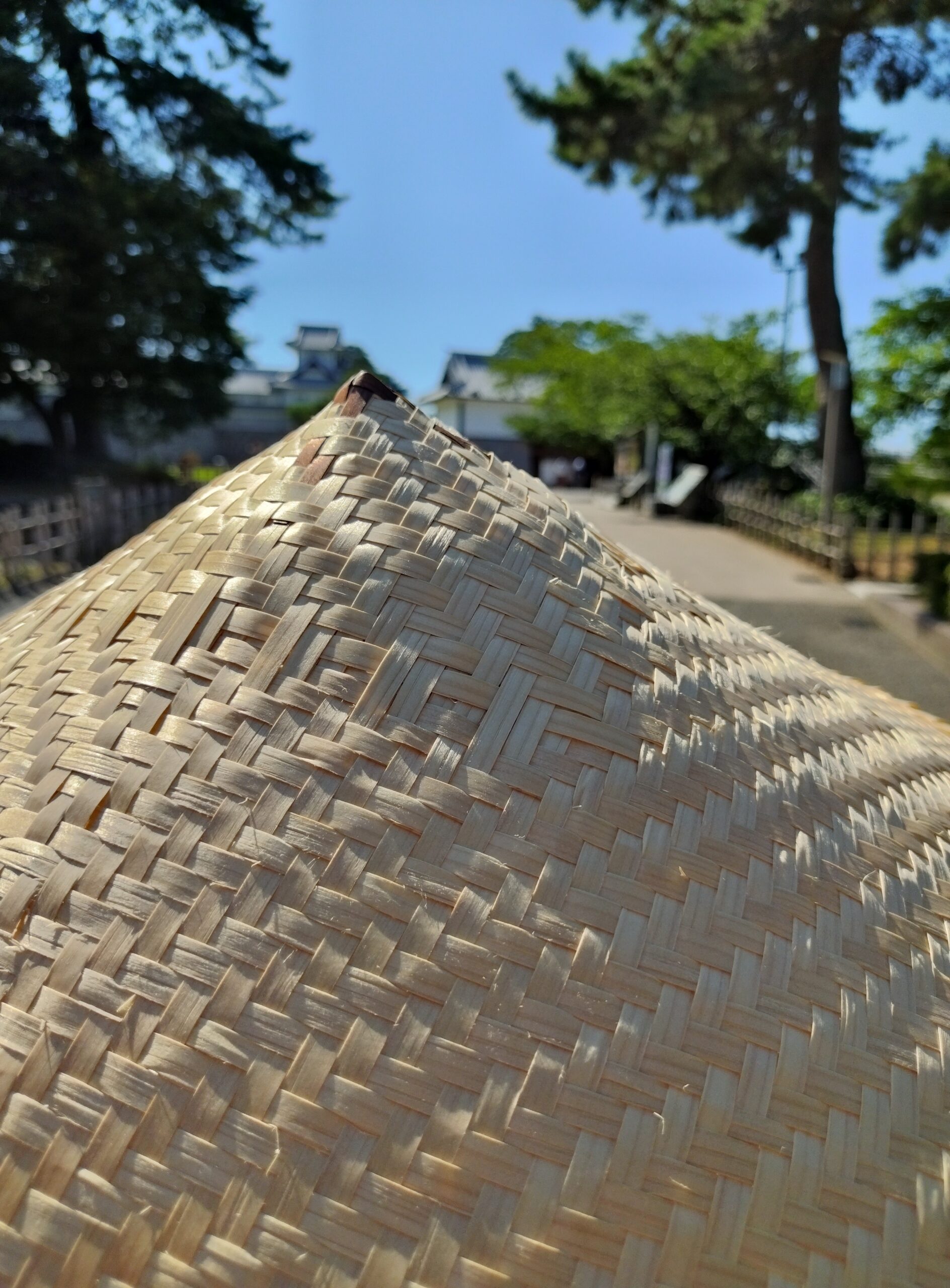本ブログは観光業、企業接待、留学生対応等で英語案内が必要ながら、多忙で準備に時間をかけられない方々の為にすぐに使える情報を分かりやすく解説しています。
👉タイトルの「桧笠 (cypress bark hats),」「網代天井(wikerwork-ceilings)」を含む関連表現は《Glossaries(用語集)》でご紹介しています。
今回は商談で訪日中の重要顧客を兼六園を案内中に『桧笠(ひのきがさ)』をかぶって庭園作業中の日本人を見て、一体何か聞かれたので、それに対応するシチュエーションです。
👉常連様向け音声演習ツールはこちらへ!

1.基本情報:『桧細工』説明前の背景知識として
まずは。いつも通り、説明用ではありませんが、背景知識として日本語から。
日本語例
- 石川県の地域ブランドとして、金沢市の近隣の市(白山市)の工房で制作されている。
- 約400年前、この地を訪れた旅の僧が桧笠(ヒノキの皮で作った低い円錐形のかぶり物)の製法を伝授したのが始まりとされる。
- 18世紀(江戸時代中期)頃から同地区の重要な特産品となっている。
- 桧細工として、桧笠の他、網代の天井や籠、花器などさまざまな民芸品が考案され、村は着実に発展していった。
- 1970年代には、ダム建設により産地が水没した為、存続が危ぶまれたが、製作者の一部が隣町に移住し現在も製作を継続している。
- ヒンナ(ヒノキの原板から作られる紙のような薄い板)は手作業で織られるが、多くの作業者は高齢者である。
英語訳例とサンプル音を付けました。その他の表現についてはもう少しお待ちください。
☛Glossaries(用語集)
a regional brand of ~(~の、地域ブランド)at a workshop(工房で)low, conical headgear(低い円錐形の被り物)made of cypress bark(桧皮製の)a traveling monk(旅の僧)to teach the craftsmen how to make(製法を伝授する)a specialty product of the area(地域の特産品)a cypress bark hat(桧笠)folk crafts(民芸品)wikerwork-ceilings(網代天井)to submerge the area(地域を水没させる)the continuation of the craft(工芸の継続)paper-thin boards(紙の様な薄い板) raw cypress boards(桧の原木)be woven by hand(手作業で織る)the weavers are elderly(織り手は高齢者)
英訳例
- As a regional brand of Ishikawa Prefecture, it is produced at a workshop in the neighboring city of Kanazawa (Hakusan City).
- It is said that the production of hinoki-kasa (low, conical headgear made of cypress bark) began about 400 years ago when a traveling monk visited the area and taught the craftsmen how to make.
- Since around the 18th century (mid-Edo period), it has become an important specialty product of the area.
- In addition to hinoki-kasa (cypress bark hats), various folk crafts were invented, such as wikerwork-ceilings, baskets, and flower vases, and the village steadily developed.
- In the 1970s, the construction of a dam submerged the production area, and the continuation of the craft was threatened, but some of the craftsmen moved to a neighboring town and continue to make their craft today.
- Hinna (paper-thin boards made from raw cypress boards) are woven by hand, and many of the weavers are elderly.

2. インバウンドの視点
いつも通り、インバウンドは日本人の日常生活にとても興味があることを踏まえ、素朴に感じるであろう疑問です。
Glossaries(用語)
a regular straw hat(通常の麦わら帽):regular retail stores in town(通常の街中の小売店):to cost on average(平均~で買える):be damaged by use(使って傷む): a temporary fashion(一時的なファッション):better ventilation(より良い通気):be made of woven cypress bark(桧の皮を編んで作られる):be retailed to the general public(一般小売りされる): to absorb moisture(水分を吸収する):this type of shade(この種の笠):throughout the aristocratic era(貴族時代/平安時代ずっと) :from the ruling class (支配層から):the common people’s life since then(それ以降の平民の生活)
2.1 インバウンドからの質問
日本語例
- 日本では最近あのような帽子が流行っているのか?
- 普通の麦わら帽子でなく何故あのような帽子を被るのか?
- そもそも、あの帽子は何でできているのか?
- どのような用途でどのような人に使われるのか?
- どこで、どのように作っているのか?
- 街中の普通の量販店で売っているのか?
- 一個、いくらぐらいで買えるのか?
- 日光だけでなく雨や雪が降る中、使っても傷まないのか?
- 以前、サムライ映画で見たことがあるがそれと同じなのか?
- いつ頃から、どのように使われてきたのか?
英訳例
- Is that type of hat currently popular in Japan?
- Why do people wear that kind of hat instead of a regular straw hat?
- What is that hat made of, exactly?
- What purposes is this hat used for, and who typically uses it?
- Where and how are they made?
- Can you find them in regular retail stores in town?
- How much does one cost on average?
- Will it be damaged by use in the rain and snow other than sunlight?
- Are these hats similar to the ones I’ve seen in Samurai movies?
- When did these hats first become popular and how have they been used throughout history?
2.2 インバウンドへの回答
回答例です。口頭で全て回答することは難しいので、その場の雰囲気に応じて、使えそうなフレーズがあればお試しください。
日本語例
- 最近流行した一時的ファッションでなく、古代から伝統的、日常的に使われてきた笠である。
- 頭上に空間ができ普通の麦わら帽子より風通しが良く夏は涼しい。、
- 色々な素材があるが石川県の生産地では主に桧の樹皮を編んで作られている。
- 現在は主に夏場の庭仕事や農作業に作業従事者や一般の人に使われる。
- 全国各地で作られているが、石川県では伝統工芸品ブランドとして工房で手作業で作られている。
- 基本的に一般小売りはしておらず、桧笠の工房や専門店で購入できる。
- 形状や大きさやによるが数千円から一万円前後で販売されている。
- 檜の皮なので水分吸収でき、日光だけでなく雨にも雪の中でも利用できる。
- このタイプの笠は雨傘と同様、貴族時代もサムライ時代も変わらず使われていたものである。
- 古代中国からアジアに広まって、日本でも古墳時代の支配層からそれ以降の庶民生活でも使われてきた。
英訳例
- It is not a temporary fashion that has recently become popular, but a traditional, everyday hat that has been used since ancient times.
- It is cooler in summer because of the space it creates above the head, which allows for better ventilation than a regular straw hat.
- It is made of various materials, but in Ishikawa Prefecture, it is mainly made of woven cypress bark.
- Currently, they are mainly used for garden and farm work in the summer by workers and the general public.
- They are made all over Japan, but in Ishikawa Prefecture, they are made by hand in workshops as a traditional craft brand.
- Basically, they are not retailed to the general public and can be purchased at hinoki-kasa workshops and specialty stores.
- They are sold at prices ranging from several thousand yen to around 10,000 yen, depending on the shape, size, and other factors.
- The hinoki bark can absorb moisture and can be used not only in the sun, but also in the rain and snow.
- This type of shade, like the rain umbrella, have been used throughout the aristocratic and samurai eras often seen in old some Japanese movies
- It spread from ancient China to Asia and has been used in Japan from the ruling class in the Kofun period to the common people’s life since then.
参照サイト
いつも通り、インバウンドは固有名詞にあまり興味を示しませんので、このブログでは最低限のことしが触れていませんが、相手が日本マニアの際には、ぜひ下記サイトをご参照ください。
石川の伝統工芸(いしかわの伝統工芸)
檜細工(桧細工)http://www.icnet.or.jp/dentou/prefecture/04.html
深瀬の檜細工(ふかぜのひのきざいく)
ひのきコースター作り体験ができます!https://www.urara-hakusanbito.com/program/detail_1586.html
深瀬桧細工工房(ふかぜひのきざいくこうぼう)ブログ
深瀬桧細工工房へようこそ!https://fukazehinoki.blogspot.com/
御礼🔶後書き
🔶今回も最後まで読んで頂き大変ありがとうございます。もし何かご意見やリクエストございましたらお気軽に『Help Desk』にてお声がけくださいませ。Gold🔶


